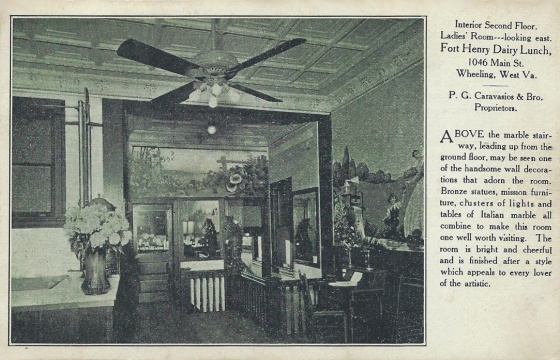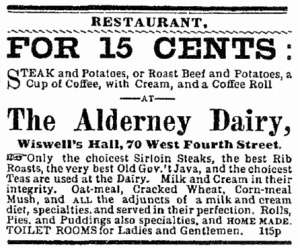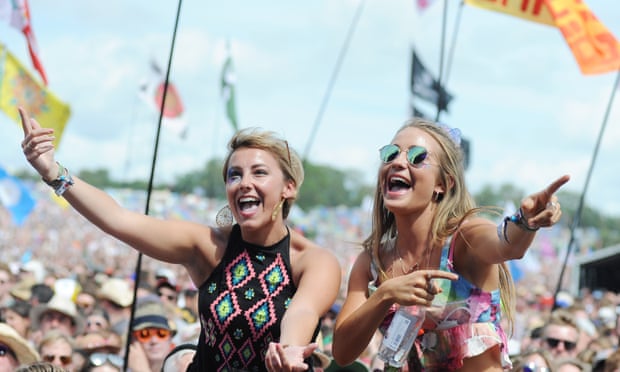
Public restrooms have been in the news lately because of conflict over transgender rights, but I have been wondering about them for quite a while as part of my project to understand how restaurants developed.
We assume that restaurants will have restrooms for their customers today, but when did they become commonplace? And when did restaurants make an effort to specifically accommodate women with separate toilets? I am still not 100% sure about the answers.
Researching the history of sanitary facilities in restaurants has proved to be very difficult, starting with what terms to search for. Even today both “bathroom” and “restroom” are somehow inadequate. Yet restroom is better to capture the historical fact that those restaurants that had facilities for women usually were outfitted with more than toilets and sinks. They also had space – and many still do – where women could take care of little chores such as repairing their hairdos, or simply rest. [restroom shown below, ca. 1920s]

Prior to the 1860s, most public toilets were outdoors, behind saloons and restaurants, and the same was true of private dwellings. Flush toilets were quite rare in the United States until the 1880s, according to Suellen Hoy’s 1995 book Chasing Dirt: The American Pursuit of Cleanliness. Outhouses were commonplace throughout the 19th century and well into the 1930s in homes in rural areas and poor neighborhoods.
The earliest ladies’ restroom I’ve found in a restaurant was in an elegant Chicago hotel. It’s likely that other hotels were similarly equipped, even though hotel bedrooms with private bathrooms were rare. According to a story in 1864, the Chicago restaurant welcomed women diners and invited them to simply “call in for a rest, without intrusion, or being thought an intruder.” “Every provision has been made for the convenience of ladies,” the story said, “and a toilet-room specially apportioned to their use.” This would have been welcome news to women at a time when public accommodations for them were sorely lacking.

The restaurants that had toilets and restrooms for women seem to have been the more substantial ones that enjoyed prominence in their communities, as was often true of restaurants in leading hotels. So it was surprising to discover that an inexpensive lunch room, Cincinnati’s Alderney Dairy, had a toilet room for women in 1878.
Though still rare, the number of ladies’ rooms in restaurants grew in the 1880s with the spread of indoor plumbing and city sewers. According to a story from 1889, restrooms in fashionable restaurants were “sumptuously furnished” with velvet couches, floor to ceiling mirrors, and marble basins. Perfumes, face powders, rouges, lotions, ivory brushes and combs, as well as hat pins were supplied.
Yet, to put the lavish restroom described above into context, the supply of ladies’ rooms in restaurants and offices was still inadequate in the 1890s. In 1891 a restaurant in Portland ME felt justified to advertise that it had “the finest Ladies’ room east of Boston,” a considerable area. Often tall office buildings were constructed with ladies’ rooms only on the top floor. Even though women were increasingly taking jobs as clerical workers in offices, developers did not want to give up income-earning space to facilities for women on each floor. (Men, on the other hand, were supplied with small closets with a urinal-sink on each floor.)
Although the 1890s is often cited as the decade in which indoor plumbing took huge leaps, it is notable that restaurants continued to advertise ladies’ rest rooms throughout the 1920s [above advertisement, 1930], indicating that it had not yet become something that could be taken for granted despite the increase in women going to restaurants.















